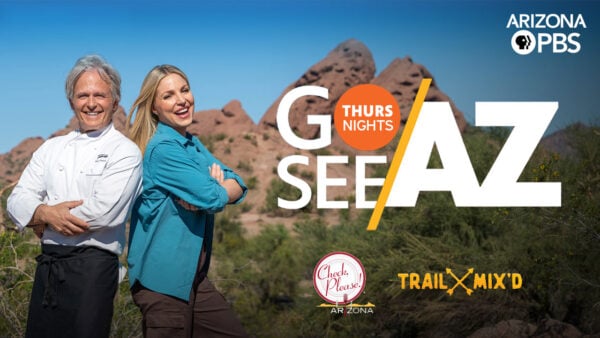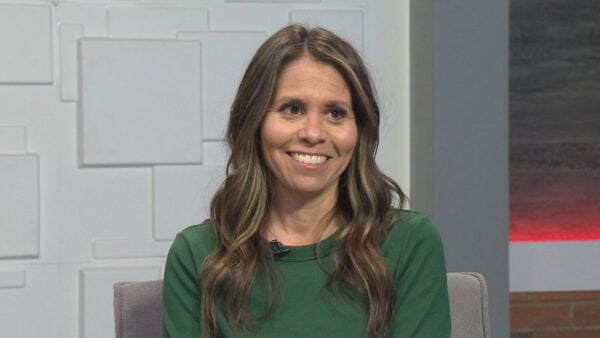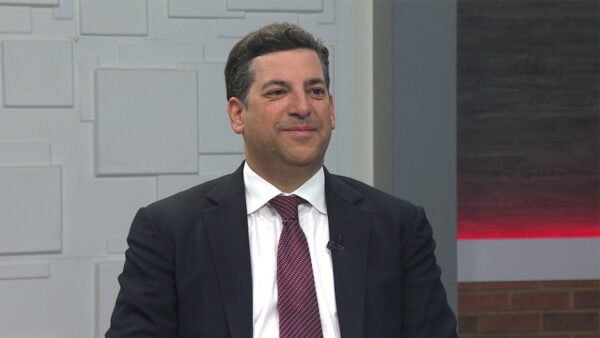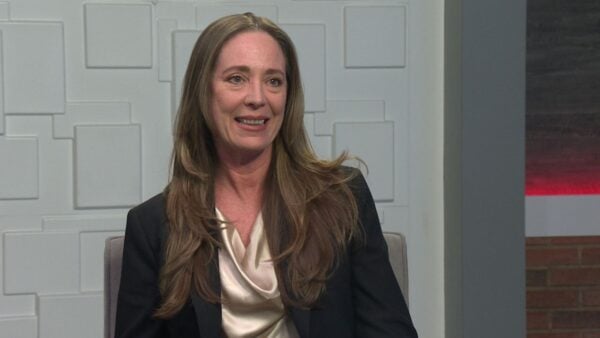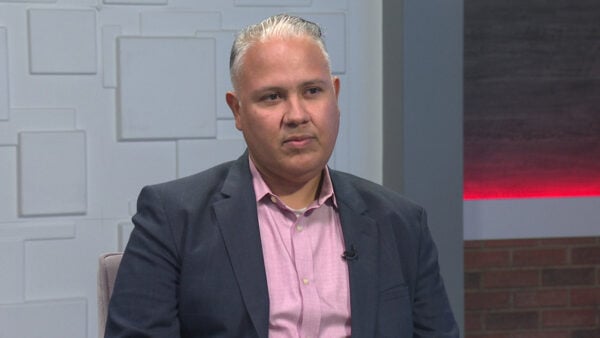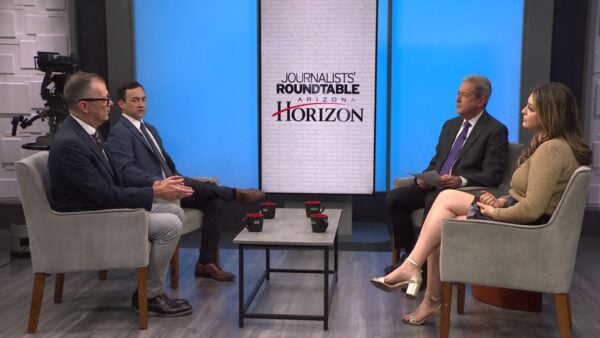Ernest McFarland served as Arizona’s governor, chief justice of the Arizona Supreme Court, and as one of Arizona’s senators. A new memorial will be dedicated to him on Arizona’s Statehood Day February 14 at the Wesley Bolin Memorial Plaza at the State Capitol. Hear from McFarland’s grandson, John D. Lewis, about his remarkable grandfather, and architect Don Ryden of Ryden Architects, Inc., who designed the new memorial.
Ted Simons: Ernest McFarland served Arizona as governor, U.S. Senator and chief justice of the state Supreme Court. A new memorial to McFarland will be dedicated on Arizona's statehood day this Saturday at the Wesley Bolin Memorial Plaza at the State Capitol. Here now to talk about the memorial and the life of Ernest McFarland is his grandson, John D. Lewis and the memorial's designer, Don Ryden of Ryden Architects. Good to have you both hero. Thank you so much for joining us. Appreciate it. Who was Earnest McFarland?
John Lewis: He was my grandfather and being brought up with him as my grandfather, I really didn't understand the depth of it but people would call him governor, senator, justice, but he always liked to be called mac. And he was just a down-to-earth guy and he was really a very hard worker. And he would get on a project or he just wouldn't let go of it until he had some kind of resolution. And that's what he did as senator for Arizona and as governor, he latched on to the water issues of the state and he just took it and ran with it and even if he fell down, he would get right back up and go at it again.
Ted Simons: Before you started on this project, were you familiar with Earnest McFarland?
Don Ryden: Yes to us children who grew up in Phoenix, we would probably most see him in often in person in parades and he was always in his cowboy outfit, he was kind of the cowboy judge that we knew him as in the '50s.
Ted Simons: When you know someone from that long ago, and now, you're charged with designing a memorial for that person, how does that creative process play out?
Don Ryden: It's really quite interesting because we have to do research on it and it's not just book learning but also with the grandkids and the family, we've got to be more personal with him. So my understanding of mac as a man really, really blossomed and gave us something to interpret in the memorial.
Ted Simons: Let's learn more about mac as a man. What brought him out to Arizona? What kept him in Arizona?
John Lewis: He came out to Arizona I believe in 1919. He was in the United States Navy for World War I. And what happened was he got pneumonia, he almost died, and they gave him a medical discharge and everything and back in those days they said go to Arizona and that's what he did. He came out here and like most all people really liked it. He stayed here, he got involved. He came here with $10 in his pocket. He started working at a bank called Valley National Bank. He was a teacher, he was trained to be a schoolteacher and he kept on his education. He went to Stanford university, got his masters in political science and, of course, his law degree. And then he kept -- started working as an assistant attorney general when governor hunt was governor here way back when. And just kept in it and kept working in politics and became a senator. It was crazy when he first ran for the Senate seat but he won. And he was a two-term U.S. senator for Arizona. And in his Senate days, he became as high as the majority leader.
Ted Simons: And he was friendss with Harry Truman, with lbj in the Senate, those were his cohorts.
John Lewis: He was very close with lbj and lbj was right behind him as a minority leader and when he was -- well not minority leader, but the whip. And then of course, he took over when my grandfather lost to Barry Goldwater in 1952. He -- he just came back to Arizona. Lbj took over my grandfather's spot and he was governor and he kept up his fight and everything else for water.
Ted Simons: And in the Senate, a co-author of the G.I. bill which I want to get to in a second. We've got the father of the G.I. bill, a friend of Lbj and Harry Truman, we've got a governor, a supreme court chief justice, United States senator, all of these things, how do you make something of that?
Don Ryden: We look for an interpretive thread that carries through the story of mac that's relevant to everybody in America, in Arizona. And so in our memorial, we try to find that and the essence of it was how did he relate to the American dream?
Ted Simons: And we're looking right now some shots of the memorial. Explain how this kind of shows us the American dream.
Don Ryden: Well, the essence of this is about growth. We have this memorial immediately next to the salute the fallen memorial, the big guns from the battle ships from World War II. And so that tells us about the sacrifice in wartime. Ours is a big spiral shape denoting growth. So it's the growth of peacetime. So it's two complementary pieces spanning the entire 20th century.
Ted Simons: When you see this memorial, and you think of your grandfather, does it make sense to you? Did you see your grandfather out there?
John Lewis: My grandfather was the kind of guy that probably wouldn't want a memorial but he got one. And yeah, I was just thinking, this memorial that we just finished is one of the largest memorials for a single person that's there. There's only what, two others down there?
Don Ryden: There's a couple more.
John Lewis: When you add in all the offices that my grandfather had and allot what he did, I think that justifies the real estate that he is occupying down there. It's well deserved, a lot of other people not just the family, would say that. And he was well loved and liked by a lot of people. And I can remember, I was working with the group of students from the Arizona state agribusiness college. I took them to Yuma, meeting farmers. This little farmer came up to me and he said earnest McFarland, he's your grandfather? He said, you know, I'm a staunch Republican but your grandfather when he was in office, we got this done, we got that done, he didn't get his Seaport built in Yuma, always looking and looking to the future, that was mac and always thinking of what needs to be done today to build for tomorrow.
Ted Simons: And there's just so much to talk about. He became owner of kptv.
John Lewis: He started it.
Ted Simons: I've always thought those call letters were kind of imaginative, ktvk - did he come up with that?
John Lewis: Yeah
Ted Simons: As far as designing this. As an architect, obviously this is not new to you, the idea of thinking, drawing, building, having. Are there any surprises along the way?
Don Ryden: There's a surprise every day and that's what makes it so much fun to do what we do, whether it's in the materials or whether it's in the procedure and getting this memorial built on state property as a gift to the people of Arizona, there's always some kind of a thing that comes up that surprises you but you know, for every single challenge that we came up against, it all turned out for the better. And the memorial is all the greater for that and I think it really points to the spirit of mac and the way he can't give up and John's the same way.
Ted Simons: Talk to us about the effort to get this done.
John Lewis: Boy, we had an old memorial there already and that had fallen into disrepair. And my mother passed away in 2003 and my father is not as active anymore and so there was a little bit of a lag there until my brothers and sisters and I got together and finally, you know, they elected me and I went and contacted the state and said all right, here I am. What can we do here? And they said what do you want to do? Give us, you know, solutions. And so we got don and we have a historian, we've been working closely with for the McFarland state park, which is down in Florence. And we just started from scratch and decided, you know, we first asked don can we save any pieces of this? And the answer was yeah, maybe. And then ken Bennett brought in the big guns there and it changed the whole landscape. The salute to the fallen memorial. And then we had to redesign again. And it was a much different process this time. We had to get approval from the legislative mall committee, we had to work with the Arizona department of administration, we had to take all of our information that we were going to post down there about my grandfather and that all to be vetted through AHAC, Arizona historical advisory committee and it was a lot of different departments of the state to go through, a lot of sweat, a lot of things got kicked back to us, but it all went through pretty well and the thing about my grandfather is he did so much. It was really -- I learned a lot more that I never knew about him. But he did so much. We had to edit, we couldn't put all on. We had to start a website, ewmcfarland.org and put the rest of the story on there. The main points will be at the memorial.
Ted Simons: We've got a couple of minutes left here. When people go out to watch, to look, to attend, to take this all in, what do you want them to see?
Don Ryden: I think that I would most want them to see a reflection of themselves in the light shone by mac. The whole place as we designed it, we designed this to be half about mac but an inspiration to the visitor to see how they, too, could make a difference and so there's something special here. There's a challenge to the people that come and see this thing as they walk through that archway. There's a surprise here. There is a surprise in the design.
Ted Simons: Interesting. Surprise for you in the design?
John Lewis: I'm just glad it's done and it looks great, and I think my family's going to be very pleased and hopefully, the state and all the visitors that go there will go there and learn something about Arizona, learn something about mac and be commemorative to mac and be inspired.
Ted Simons: Again, if you go to this memorial and you see this, be inspired is one thing but what do you want them to know about your grandfather? There's even more. The losing to Goldwater, coming back and being the governor, still being the state Supreme Court justice, wrote the Miranda ruling, he's all over the place.
John Lewis: Yeah, he is. I would like for them to go and find a piece of themselves in my grandfather. For example, my grandfather, he was elected Pinal county superior court judge. He met his first wife, started a family and right in 1930, they all died from disease. And he got right back up, came back, married my grandmother, and adopted my mother and off he went. And he just, like I said, he never gave up. He kept going and that happens to a lot of people where we're kicked down and it's not that you get kicked down. It's how you get back up.
Ted Simons: You have three kids die, wife died young, that's serious stuff back in those days, that wasn't necessarily all that uncommon was it?
John Lewis: That was all during the depression.
Ted Simons: Now, we've got just about a minute left here. I want something a little off McFarland but in the concept of memorials. What is a good memorial?
Don Ryden: A good memorial is a place that has a sense of relevance to you as a person, that you just don't go look at a big stone with a plaque on it and go okay next. But something that touches you, something that challenges you. And find something that is a thread in your life and in this case it's how the American dream is left. It's not you reaching your dream but leaving the legacy to others on the way to your dream that we're talking about.
Ted Simons: All right, we're looking forward to checking that out. Congratulations, on a great memorial. Congratulations on your grandfather having a great life.
Ted Simons: Friday on "Arizona Horizon," it's the Journalists' Roundtable. We will have much more on the public fight between the governor and the school's chief. And we'll look at why the governor replaced the director of the Department of Child Safety. That's Friday on the Journalists Roundtable. That is it for now. I'm Ted Simons, thank you so much for joining us. You have a great evening.
Video: "Arizona Horizon" is made possible by contributions from the friends of eight, members of your Arizona PBS station, thank you.
John D. Lewis:Grandson, Ernest McFarland; Don Ryden:Architect, Ryden Architects, Inc.;
